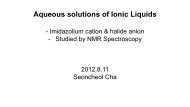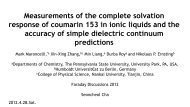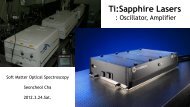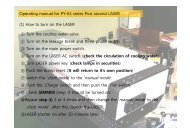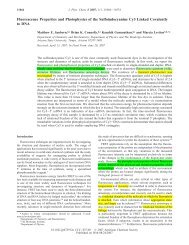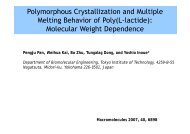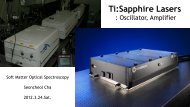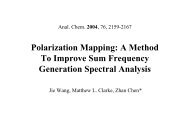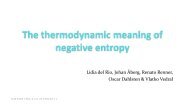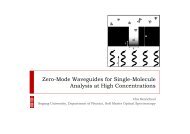A Newtonian approach to extraordinarily strong negative refraction
A Newtonian approach to extraordinarily strong negative refraction
A Newtonian approach to extraordinarily strong negative refraction
Create successful ePaper yourself
Turn your PDF publications into a flip-book with our unique Google optimized e-Paper software.
Journal Club – 2012.09.14<br />
A <<strong>strong</strong>>New<<strong>strong</strong>>to</<strong>strong</strong>>nian</<strong>strong</strong>> <<strong>strong</strong>>approach</<strong>strong</strong>> <<strong>strong</strong>>to</<strong>strong</strong>> <<strong>strong</strong>>extraordinarily</<strong>strong</strong>> <strong>strong</strong><br />
<strong>negative</strong> <strong>refraction</strong><br />
Hosang Yoon, Kitty Y. M. Yeung, Vladimir Umansky & Donhee Ham<br />
Nature 488, 65-69 (2012)
Metamaterial and <strong>negative</strong> <strong>refraction</strong><br />
Metamaterial – having both m < 0, e < 0<br />
n = mre r <<br />
0<br />
http://en.wikipedia.org/wiki/Split-ring_resona<<strong>strong</strong>>to</<strong>strong</strong>>r<br />
<br />
sinq<br />
n<br />
sinq<br />
n<br />
=<br />
1 2<br />
2 1<br />
http://www.nature.com/nature/journal/v480/n7375/fig_tab/4800<br />
42a_F1.html
2D-electron system in semiconduc<<strong>strong</strong>>to</<strong>strong</strong>>r strip<br />
l=112mm, a=1.25mm, W=1mm<br />
and number of strip ~13<br />
Motion of 2DEG is induced<br />
by external EM field. (along<br />
xy-plane)
Band bending and modulation dopping<br />
Energy level of conduction band<br />
Energy level of conduction band<br />
(1) (2)<br />
AlGaAs : ~2eV GaAs : 1.42eV<br />
z-direction<br />
(3)<br />
Al+<br />
Al+<br />
Al+<br />
~ No free electrons<br />
Immigration of electron<br />
e- e- e- Fermi level<br />
Fermi level<br />
Energy level of conduction band<br />
Si<br />
S<br />
i<br />
Si<br />
Silicon doping<br />
Energy level of conduction band<br />
e- Al+<br />
(4)<br />
Si = +
2D-electron motion and kinetic inductance<br />
: Equation of motion<br />
i( kx-wt )<br />
Under AC field (eg. Electromagnetic wave) V ( x, t) = Ve<br />
With a definition of current in this system I = -n2DevW<br />
Z = iwL +<br />
R<br />
k ,2D<br />
: expression of impedance
Derivation of refractive index from L 2D,k<br />
With circuit equations in this system,<br />
After inserting V in induced by electromagnetic wave,
Derivation of refractive index from L 2D,k<br />
1<br />
- w V e ( e + e - 2) = V e<br />
2 ( wt-kma ) ika -ika ( wt-kma )<br />
0<br />
LK ,2DC<br />
0<br />
So, dispersion relation can be expressed as,<br />
From definition of refractive index,<br />
Negative value if w ><br />
wc
Comparison between 2D and 3D system<br />
Kinetic and magnetic inductance of single 3D gold nano particle<br />
Kinetic and magnetic inductance of 2DEG strip array<br />
2DEG strip system has larger kinetic inductance<br />
* Carrier density for silver is around 1 x 10 28 m -3
Result of simulated dispersion curve and current<br />
Dispersion curve indicates that group and phase velocity<br />
have opposite sign.<br />
Frequency above cu<<strong>strong</strong>>to</<strong>strong</strong>>ff creates high current density on the<br />
stripes.
Measurement of microwave<br />
Effective wavenumber<br />
can be extracted from S<br />
parameters
Transfer and scattering matrix
Temperature dependence<br />
In room temperature, strip has<br />
high resistance (~100kOhm)<br />
Kinetic inductance is reduced<br />
and system acts as open circuit
Effect of system dimension
Summary<br />
1. From the metamaterial having 2DEG Strong <strong>negative</strong> refractive index was<br />
observed in GHz range.<br />
2. Origin of <strong>negative</strong> <strong>refraction</strong> dominantly came from collective motion of<br />
electrons in the strip array which related <<strong>strong</strong>>to</<strong>strong</strong>> kinetic inductance.<br />
3. Temperature and size dependence of n was studied.



